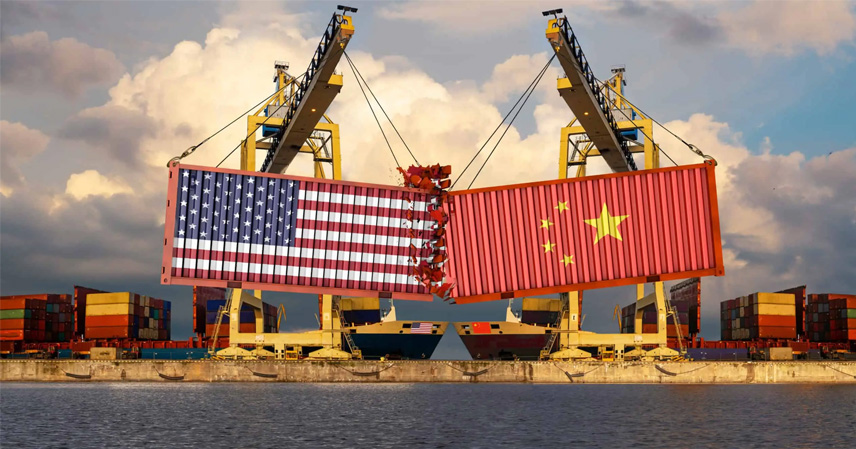The U.S.-China tariff war has dragged on for years, reshaping global trade flows and unsettling markets worldwide. No matter how long it lasts, it will inevitably come to an end — but only three realistic outcomes await:
- Mutual destruction, where both nations suffer significant losses.
- A costly Chinese victory, in which China withstands the blow but endures economic pain.
- A U.S. retreat under domestic pressure, leading Washington to seek reconciliation with Beijing.
Former President Donald Trump, however, envisions a fourth scenario — that the U.S. can defeat China outright through tariffs. Yet, analysts around the world agree: such an outcome is little more than wishful thinking.
1. Mutual Destruction: The Most Realistic Path
Trade is inherently interdependent — your gain is my gain. Once tariffs escalate, both sides get hurt.
In the 2018 round of tariff battles, American consumers paid over $10 billion more annually, with each household spending about $1,300 extra for imported goods. The 2025 version is even more severe. Trump’s 10% baseline tariff immediately fueled inflation, forcing retailers to raise prices. From furniture to electronics, store shelves across the U.S. reflected the price shock.
In China, export orders plunged, factories faced underutilization, and unemployment pressure rose. Globally, the supply chain fractured— ports in Vietnam and Mexico overflowed with redirected containers. Economists estimate that if these high tariffs persist for several years, U.S. GDP could shrink by 0.5%, while China’s export growth would slow significantly.
Farmers in the American Midwest saw soybeans rot in silos, while Chinese manufacturers struggled to obtain essential components. As the IMF has repeatedly warned, “there are no winners in a trade war.” The 2025 escalation, which rattled Asian markets and sent European and U.S. stocks tumbling, only confirms the damage cuts both ways.
2. A Costly Chinese Victory: Resilience Amid Pain
While both economies are suffering, China holds greater structural resilience. With a vast domestic market and diversified exports, Beijing has more room to maneuver.
When Trump raised tariffs, China retaliated with 15% levies on U.S. chicken, wheat, and corn, and even higher rates on soybeans and pork. The impact was immediate — American farmers protested as subsidies failed to cover the losses.
Meanwhile, China quickly pivoted trade toward Southeast Asia and Europe, leveraging the Belt and Road framework. By mid-2025, a Geneva interim deal reduced tariffs modestly — U.S. duties dropped to 30%, and China’s to 10%, providing brief relief.
Analysts call this a “painful victory” for China. The country’s manufacturing ecosystem remains intact, while U.S. firms like Apple and Nike struggle with production costs. Tariffs have backfired by squeezing U.S. profit margins and inflating consumer prices.
Experts widely agree that America’s trade deficit stems not from unfair trade, but from its own high consumption and low savings. China, although hurt by factory closures and declining orders, has strengthened trade with ASEAN — setting a record surplus in 2024. In this scenario, China survives, but both sides emerge weaker and bruised.
3. The U.S. Backs Down: Domestic Pressure Forces a Truce
The third and perhaps most likely outcome is that domestic opposition in the U.S. overwhelms political stubbornness. With industrial workers laid off, farmers lobbying Congress, and major corporations complaining about rising costs, Washington could be pushed to negotiate peace.
In 2025, when Trump threatened 100% tariffs, Wall Street panicked. Goldman Sachs warned that American consumers would bear 55% of the total tariff cost, reigniting inflation concerns and limiting the Federal Reserve’s ability to control prices.
Farm lobby groups flooded Capitol Hill, demanding relief. The scene mirrors 2019, when Trump, under election pressure, signed the “Phase One” agreement with China.
Now, as the Frankfurt summit approaches, speculation grows about a 90-day truce extension — signaling a desire to cool tensions. China’s Ministry of Commerce responded diplomatically: “We can fight, but we are always open to talk.” Beijing is ready to de-escalate if Washington shows sincerity.
International observers — from the BBC to The New York Times — view this route as the most pragmatic. America’s economy cannot endure an endless tariff war, and even its allies in Europe and Japan urge restraint. A stabilized trade relationship, even without fully removing tariffs, would restore global supply chain flow and tame inflationary pressure.
4. Trump’s Wishful Thinking: The Myth of a U.S. Victory
Trump’s “fourth outcome” — a total American triumph — has been his narrative since his first term. He believes tariffs can eliminate trade deficits and “defend American jobs.” Yet this is economic fantasy in a globalized world.
By 2025, his 60–100% tariff proposals only deepened the strain on U.S. companies. Port fees surged, import costs soared, and many firms cut orders from China to survive.
Experts note that globalization has tied economies too tightly for such decoupling to work. Even U.S. allies like Brazil and Australia maintain stronger surpluses with China than with the U.S., reflecting where global demand truly lies.
Trump’s aggressive posture is viewed internationally as negotiation theater, not viable policy. Economic studies worldwide conclude that America cannot “win” a tariff war — because cutting off China means cutting off itself.
References:
- IMF Global Trade Outlook Reports (2018–2025)
- Goldman Sachs Consumer Impact Analysis (2025)
- Chinese Ministry of Commerce press briefings (2025)
- BBC and The New York Times trade coverage



